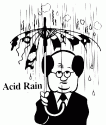What is Acid Rain?

The term acid rain refers to what scientists call acid deposition. It is caused by airborne acidic pollutants and has highly destructive results.
Scientists first discovered acid rain in 1852, when the English chemist Robert Agnus invented the term. From then until now, acid rain has been an issue of intense debate among scientists and policy makers.
Acid rain, one of the most important environmental problems of all, cannot be seen. The invisible gases that cause acid rain usually come from automobiles or coal-burning power plants.
Causes
For many years, there was considerable debate and disagreement over what caused acid rain. Recent scientific work, however, has helped to clarify this
The primary causes of acid rain are sulfur dioxide and nitrogen oxides. These chemicals are released by certain industrial processes, and as a result, the more industrialized nations of Europe as well as the US suffer severely from acid rain.
Most sulfur dioxide comes from power plants that use coal as their fuel. These plants emit 100 million tons of sulfur dioxide, 70% of that in the world.
Automobiles produce about half of the world’s nitrogen oxide. As the number of automobiles in use increases, so does the amount of acid rain. Power plants that burn fossil fuels also contribute significantly to nitrogen oxide emission.
Though human causes are primarily responsible for acid rain, natural causes exist as well. Fires, volcanic eruptions, bacterial decomposition, and lightening also greatly increase the amount of nitrogen oxide on the planet. However, even the gigantic explosion of Mt.St. Helens released only about what one coal power plant emits in a year.
Once the tiny pollutant molecules have entered the atmosphere, they can travel for thousands of miles. Eventually, the particles will combine with other compounds to produce new, often harmful, chemicals.
Acid rain comes down to the earth in the form of rain, snow, hail, fog, frost, or dew. Once it reaches the ground, the acidity in the substance can harm and even destroy both natural ecosystems and man-made products, such as car finishes.
Acid rain moves easily, affecting locations far beyond those that let out the pollution. As a result, this global pollution issue causes great debates between countries that fight over polluting each other’s environments.
For years, science studied the true causes of acid rain. Some scientists concluded that human production was primarily responsible, while others cited natural causes as well. Recently, more intensive research has been done so that countries have the information they need to prevent acid rain and its dangerous effects.
The levels of acid rain vary from region to region. In Third World nations without pollution restrictions, acid rain tends to be very high. In Eastern Europe, China, and the Soviet Union, acid rain levels have also risen greatly. However, because acid rain can move about so easily, the problem is definitely a global one.
Effects
Acid rain is having harmful effects both on people and on the natural ecosystems of the world. Scientists today are convinced that acid rain is severe in many areas, and that it is having an adverse effect on the environments of those locations.
The problem of acid rain is rapidly spreading. Because it is mainly caused by industrial processes, automobiles, and power plants, those countries that are developed have the most severe acid rain problems. However, as the undeveloped nations begin to industrialize, acid rain will increase greatly.
Determining just how much the planet is being hurt by acid rain is very difficult because the ecosystem that it affects are so diverse and complex.
Many ecosystems are affected by acid rain. Bodies of water, such as lakes and rivers, see many of their inhabitants die off due to rising acidity levels.
Acidic water also ruins plant nutrients, hurting plants’ ability to survive and to give life to other organisms.
Human-made products are also experiencing degradation from acid rain. Cars can lose their finishes, and outdoor statues are beginning to rust.
Acid rain’s effects are destructive and long lasting. Though scientists have studied lakes, streams, and many other natural ecosystems to prove its negative effects, acid rain continues to be produced and is increasing in many parts of the world.





Laisser un commentaire!